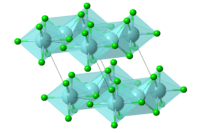Zirconium(III) chloride
 | |
| Names | |
|---|---|
| IUPAC name
Zirconium trichloride | |
| Identifiers | |
| 10241-03-9 | |
| 3D model (Jmol) | Interactive image |
| ChemSpider | 127679 |
| PubChem | 144719 |
| |
| |
| Properties | |
| Cl3Zr | |
| Molar mass | 197.57 g·mol−1 |
| Appearance | Blue-black crystals |
| Density | 3.05 g/cm3[1] |
| Melting point | 627 °C (1,161 °F; 900 K) at 760 mmHg[1] |
| Reacts[1] | |
| Solubility | Soluble in phenyls, CS2 |
| Structure | |
| Hexagonal, hP6[2] | |
| P63/mcm, No. 193[2] | |
| 6/m 2/m 2/m[2] | |
| α = 90°, β = 90°, γ = 120° | |
| Thermochemistry | |
| 96.21 J/mol·K[3] | |
| Std molar entropy (S |
145.79 J/mol·K[3] |
| Std enthalpy of formation (ΔfH |
−714.21 kJ/mol[3] |
| Except where otherwise noted, data are given for materials in their standard state (at 25 °C [77 °F], 100 kPa). | |
| | |
| Infobox references | |
Zirconium(III) chloride is an inorganic compound with formula ZrCl3. It is a blue-black solid that is highly sensitive to air.
Preparation
The material was first claimed by Ruff and Wallstein who reduced zirconium tetrachloride with aluminium to give impure samples.[4] Subsequently, the problem with aluminium contamination was solved when it was prepared by reduction using zirconium metal:[5]
- Zr + 3 ZrCl4 → 4 ZrCl3
When aluminium is used as the reducing agent with zirconium tetrachloride, a series of choloroaluminates are formed, for example [Zr(AlCl4)2(AlCl4)2] and Zr(AlCl4)3.[6]
Since the trihalides, such as zirconium trichloride, are comparatively nonvolatile, contamination can be avoided by using a gaseous reductant. For example, zirconium trichloride can be prepared by reduction of zirconium tetrachloride with hydrogen.[7]
- ZrCl4 + ½ H2 → ZrCl3 + HCl
Structure
Some zirconium halides (ZrCl3, ZrBr3, and ZrI3) have structures similar to HfI3. They also have similar space group (P63/mcm) and hexagonal structure with 2 molecules in the cell.[2] The magnetic susceptibility of zirconium trichloride suggests metal-metal interactions of the unpaired electron on each Zr(III) center. The magnetic moment of ZrCl3 (0.4 BM) indicates considerable overlap of metal orbitals.[8]
References
- 1 2 3 Lide, David R., ed. (2009). CRC Handbook of Chemistry and Physics (90th ed.). Boca Raton, Florida: CRC Press. ISBN 978-1-4200-9084-0.
- 1 2 3 4 5 Douglas, Bodie E.; Ho, Shih-Ming (2007). Structure and Chemistry of Crystalline Solids. New York: Springer Science+Business Media, Inc. p. 101. ISBN 0-387-26147-8.
- 1 2 3 Zirconium chloride in Linstrom, P.J.; Mallard, W.G. (eds.) NIST Chemistry WebBook, NIST Standard Reference Database Number 69. National Institute of Standards and Technology, Gaithersburg MD. http://webbook.nist.gov (retrieved 2014-06-23)
- ↑ Ruff, Otto; Wallstein, Richard (1923). "Reduktion anorganischer Halogenide III.1) Die Reduktion des Zirkontetrachlorids". Zeitschrift für anorganische und allgemeine Chemie. 128: 96. doi:10.1002/zaac.19231280110.
- ↑ Hoffman, David M.; Lee, Samkeun (1992). "Synthesis of pyridine complexes of zirconium(III) chloride and the apparent oxidation to zirconium(IV) by a nitrile". Inorganic Chemistry. 31 (13): 2675. doi:10.1021/ic00039a002.
- ↑ Larsen, E. M.; Moyer, James W.; Gil-Arnao, Francisco.; Camp, Michael J. (1974). "Synthesis of crystalline zirconium trihalides by reduction of tetrahalides in molten aluminum halides. Nonreduction of hafnium". Inorganic Chemistry. 13 (3): 574. doi:10.1021/ic50133a015.
- ↑ Newnham, I. E.; Watts, J. A. (1960). "The Preparation of the Anhydrous Zirconium Trihalides". Journal of the American Chemical Society. 82 (9): 2113. doi:10.1021/ja01494a006.
- ↑ Wells, A.F. Structural Inorganic Chemistry. Oxford Science Publications, 1975, 5th ed, 417-420.